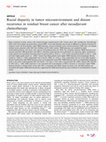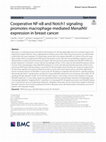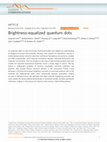Papers by David Entenberg

NPJ breast cancer, Jun 13, 2023
Black, compared to white, women with residual estrogen receptor-positive (ER+) breast cancer afte... more Black, compared to white, women with residual estrogen receptor-positive (ER+) breast cancer after neoadjuvant chemotherapy (NAC) have worse distant recurrence-free survival (DRFS). Such racial disparity may be due to difference in density of portals for systemic cancer cell dissemination, called TMEM doorways, and pro-metastatic tumor microenvironment (TME). Here, we evaluate residual cancer specimens after NAC from 96 Black and 87 white women. TMEM doorways are visualized by triple immunohistochemistry, and cancer stem cells by immunofluorescence for SOX9. The correlation between TMEM doorway score and pro-metastatic TME parameters with DRFS is examined using log-rank and multivariate Cox regression. Black, compared to white, patients are more likely to develop distant recurrence (49% vs 34.5%, p = 0.07), receive mastectomy (69.8% vs 54%, p = 0.04), and have higher grade tumors (p = 0.002). Tumors from Black patients have higher TMEM doorway and macrophages density overall (p = 0.002; p = 0.002, respectively) and in the ER+/HER2-(p = 0.02; p = 0.02, respectively), but not in the triple negative disease. Furthermore, high TMEM doorway score is associated with worse DRFS. TMEM doorway score is an independent prognostic factor in the entire study population (HR, 2.02; 95%CI, 1.18-3.46; p = 0.01), with a strong trend in ER+/HER2-disease (HR, 2.38; 95% CI, 0.96-5.95; p = 0.06). SOX9 expression is not associated with racial disparity in TME or outcome. In conclusion, higher TMEM doorway density in residual breast cancer after NAC is associated with higher distant recurrence risk, and Black patients are associated with higher TMEM doorway density, suggesting that TMEM doorway density may contribute to racial disparities in breast cancer.

Journal of Immunology, May 1, 2022
The Cxcl12/Cxcr4 signaling axis promotes metastasis in mouse models of breast carcinoma and is li... more The Cxcl12/Cxcr4 signaling axis promotes metastasis in mouse models of breast carcinoma and is linked with increased metastatic risk in humans. Prior studies have linked Cxcl12/Cxcr4 to breast cancer cell homing and survival at metastatic sites. However, the precise mechanism via which Cxcr4+ breast cancer cells escape primary tumors, which also express Cxcl12, is poorly understood. By using a novel imaging method for visualizing chemokine gradients, we show that Cxcl12 is concentrically expressed around cancer cell intravasation doorways, known as Tumor Microenvironment of Metastasis (TMEM). Using distance analysis algorithms, we also show that TMEM-mediated Cxcl12 gradients contextually associate with Cxcr4+ breast cancer cells migrating towards TMEM doorways. As such, pharmacological inhibition of the Cxcl12/Cxcr4 axis significantly abrogates translocation of Cxcr4+ cancer cells to TMEM doorways, thus suppressing metastatic dissemination. However, the targeted elimination of Cxcr4 from breast cancer cells paradoxically results in a suboptimal response compared to pharmacologic inhibition, implying the existence of a compensatory mechanism. Using clodronate-mediated macrophage depletion, we demonstrate that, in the absence of Cxcr4 expression in tumor cells, accompanying Cxcr4+ macrophages may still “read” TMEM-generated Cxcl12 chemotactic gradients. Indeed, Pdgfrb+ stromal cells may express low levels of Cxcl12, but TMEM-generated Cxcl12 gradients are primarily linked to a subset of Iba1+ perivascular tumor-associated macrophages. Overall, our data reveal a new paradigm for the implication of Cxcl12/Cxcr4 in early stages of metastasis and propose an avenue for rationalized antimetastatic treatments. Supported by Recruitment Funds RECR 3A3218

Cancer Research, Jun 15, 2022
The Cxcl12/Cxcr4 signaling axis has been shown to promote metastasis in multiple mouse models of ... more The Cxcl12/Cxcr4 signaling axis has been shown to promote metastasis in multiple mouse models of breast carcinoma and to be associated with increased metastatic risk in humans. Indeed, prior studies have specifically linked Cxcl12/Cxcr4 to breast cancer cell seeding, homing, survival and proliferation at future metastatic sites, due to the aberrant Cxcl12 expression in these sites (e.g. lung, liver and bone marrow). Interestingly however, the precise mechanism via which Cxcr4+ breast cancer cells escape the primary tumors in the first place (which also highly express Cxcl12), remains poorly understood. By using a novel methodology for quantifying chemotactic gradients using fixed tissue multichannel immunofluorescence (mIF), here, we demonstrate in mouse primary breast tumors that Cxcl12 gradients are concentrically expressed around cancer cell intravasation sites, known as Tumor Microenvironment of Metastasis (TMEM) doorways. Via distance analysis algorithms using mIF, we also demonstrate that TMEM-mediated Cxcl12 gradients contextually associate with Cxcr4+ breast cancer cells migrating towards the underlying TMEM doorways. As such, pharmacological inhibition of the Cxcl12/Cxcr4 pathway significantly abrogates the translocation of Cxcr4+ cancer cells to TMEM doorways, suppressing TMEM-mediated metastatic dissemination. However, targeted elimination of the Cxcr4+ gene specifically from breast cancer cells, paradoxically results in a suboptimal response, thus suggesting the existence of a bypass or compensatory mechanism. Previously, it was shown that Cxcr4+ tumor-associated macrophages (TAMs) support the invasive and migratory properties of tumor cells utilizing TMEM doorways. We thus theorized that, in the absence of Cxcr4 expression in tumor cells, the accompanying Cxcr4+ TAMs may still “read” TMEM-generated Cxcl12 chemotactic gradients. Indeed, clodronate-mediated TAM depletion results in the significant suppression of Cxcr4+ cancer cell translocation to TMEM doorways and their subsequent dissemination to the peripheral circulation and future metastatic sites. Finally, we used a variety of stromal and immune cell lineage markers to identify the precise source of TMEM-generated Cxcl12 gradients in mouse primary breast cancers. Despite that blood vessels (irrespective of presence of TMEM doorways) were primarily lined by Pdgfrb+ stromal cells with basal Cxcl12 expression, TMEM-generated Cxcl12 gradients were specifically linked to a subset of Cxcl12+Iba1+ perivascular TAMs. Pharmacological inhibition of Pdgfrb depletes Pdgfrb+Cxcl12+ stromal cells, but does not significantly affect Cxcl12/Cxcr4- mediated translocation of Cxcr4+ tumor cells to TMEM doorways. Overall, our data support a new paradigm for the implication of the Cxcl12/Cxcr4 axis during the early stages of the metastatic cascade, and propose a new avenue for rationalized antimetastatic treatments for breast cancer. Citation Format: Maria K. Lagou, Luis G. Rivera, Camille E. Duran, Joseph Burt, Xiaoming Chen, Yu Lin, Robert Eddy, Allison S. Harney, David Entenberg, John S. Condeelis, Maja H. Oktay, George S. Karagiannis. An emerging paradigm of Cxcl12/Cxcr4 involvement in breast cancer metastasis [abstract]. In: Proceedings of the American Association for Cancer Research Annual Meeting 2022; 2022 Apr 8-13. Philadelphia (PA): AACR; Cancer Res 2022;82(12_Suppl):Abstract nr 3124.

Breast Cancer Research, Apr 6, 2023
Metastasis is a multistep process that leads to the formation of clinically detectable tumor foci... more Metastasis is a multistep process that leads to the formation of clinically detectable tumor foci at distant organs and frequently to patient demise. Only a subpopulation of breast cancer cells within the primary tumor can disseminate systemically and cause metastasis. To disseminate, cancer cells must express MenaINV, an isoform of the actin regulatory protein Mena, encoded by the ENAH gene, that endows tumor cells with transendothelial migration activity, allowing them to enter and exit the blood circulation. We have previously demonstrated that MenaINV mRNA and protein expression is induced in cancer cells by macrophage contact. In this study, we discovered the precise mechanism by which macrophages induce MenaINV expression in tumor cells. We examined the promoter of the human and mouse ENAH gene and discovered a conserved NF-κB transcription factor binding site. Using live imaging of an NF-κB activity reporter and staining of fixed tissues from mouse and human breast cancer, we further determined that for maximal induction of MenaINV in cancer cells, NF-κB needs to cooperate with the Notch1 signaling pathway. Mechanistically, Notch1 signaling does not directly increase MenaINV expression, but it enhances and sustains NF-κB signaling through retention of p65, an NF-κB transcription factor, in the nucleus of tumor cells, leading to increased MenaINV expression. In mice, these signals are augmented following chemotherapy treatment and abrogated upon macrophage depletion. Targeting Notch1 signaling in vivo decreased NF-κB signaling activation and MenaINV expression in the primary tumor and decreased metastasis. Altogether, these data uncover mechanistic targets for blocking MenaINV induction that should be explored clinically to decrease cancer cell dissemination and improve survival of patients with metastatic disease.
Biophotonics Congress: Biomedical Optics 2020 (Translational, Microscopy, OCT, OTS, BRAIN), 2020
We use Surgical Engineering to overcome technical challenges to intravital imaging, improving its... more We use Surgical Engineering to overcome technical challenges to intravital imaging, improving its ability to perform mechanistic, hypothesis-driven investigations of live tissues and making surprising discoveries about how cancer cells spread.
CRC Press eBooks, Dec 3, 2020
IntraVital, Apr 29, 2016
The tumor microenvironment is recognized as playing a significant role in the behavior of tumor c... more The tumor microenvironment is recognized as playing a significant role in the behavior of tumor cells and their progression to metastasis. However, tools to manipulate the tumor microenvironment directly, and image the consequences of this manipulation with single cell resolution in real time in vivo, are lacking. We describe here a method for the direct, local manipulation of microenvironmental parameters through the use of an implantable Induction Nano Intravital Device (iNANIVID) and simultaneous in vivo visualization of the results at single-cell resolution. As a proof of concept, we deliver both a sustained dose of EGF to tumor cells while intravital imaging their chemotactic response as well as locally induce hypoxia in defined microenvironments in solid tumors.

Current Biology, Nov 1, 2013
Background: Tks5 regulates invadopodium formation, but the precise timing during invadopodium lif... more Background: Tks5 regulates invadopodium formation, but the precise timing during invadopodium lifetime (initiation, stabilization, maturation) when Tks5 plays a role is not known. Results: We report new findings based on high-resolution spatiotemporal live-cell imaging of invadopodium precursor assembly. Cortactin, N-WASP, cofilin, and actin arrive together to form the invadopodium precursor, followed by Tks5 recruitment. Tks5 is not required for precursor initiation but is needed for precursor stabilization, which requires the interaction of the phox homology (PX) domain of Tks5 with PI(3,4)P 2. During precursor formation, PI(3,4)P 2 is uniformly distributed but subsequently starts accumulating at the precursor core 3-4 min after core initiation, and conversely, PI(3,4,5)P 3 gets enriched in a ring around the precursor core. SHIP2, a 5 0-inositol phosphatase, localizes at the invadopodium core and regulates PI(3,4)P 2 levels locally at the invadopodium. The timing of SHIP2 arrival at the invadopodium precursor coincides with the onset of PI(3,4)P 2 accumulation. Consistent with its late arrival, we found that SHIP2 inhibition does not affect precursor formation but does cause decreases in mature invadopodia and matrix degradation, whereas SHIP2 overexpression increases matrix degradation. Conclusions: Together, these findings lead us to propose a new sequential model that provides novel insights into molecular mechanisms underlying invadopodium precursor initiation, stabilization, and maturation into a functional invadopodium.
Gastroenterology, May 1, 2023

Cancer Research, Apr 4, 2023
Introduction: Pancreatic adenocarcinoma (PDAC) is highly lethal due to overwhelming metastatic bu... more Introduction: Pancreatic adenocarcinoma (PDAC) is highly lethal due to overwhelming metastatic burden [1]. The mechanisms underpinning metastasis in PDAC have not been identified. The TMEM doorway is the sole portal of intravasation in breast cancer [2, 3]. Importantly, intravasation and dissemination via TMEM doorways is inhibited by Tie2 blockade in breast cancer [4]. We evaluated whether TMEM Doorways are a common targetable mechanism of dissemination in PDAC. Methods: Tumor samples from treatment-naïve patients who underwent curative-intent resection of PDAC were stained for TMEM doorways using a triple immunohistochemistry (IHC) stain (tumor cells expressing the actin regulatory protein Mena, macrophages expressing CD68, and endothelial cells expressing CD31). TMEM doorways were manually counted in the highest TMEM doorway-bearing 400x field (hotspot) identified at 100x scanning magnification for each case. TMEM doorway function was assessed in a murine model of PDAC treated with or without rebastinib (an investigational oral Tie2 inhibitor [4]) by analyzing; (1) TMEM doorway mediated opening using high-molecular weight dextran (155kD-TMR dextran); (2) circulating tumor cells and (3) disseminated tumor cells in murine livers. The Wilcoxon Test was used for the human TMEM doorway scoring comparisons. A student t-test was used for the murine analyses. Results: TMEM doorways were observed in all PDAC tumors from 50 unique treatment-naïve patients. The TMEM doorway score was ≈6x higher than observed in published breast cancer patient samples. Mean TMEM doorway score in “hotspots” from resected human PDAC was 19 and 34 in low- and high-grade tumors, respectively (p-value < 0.01). TMEM doorway mediated opening was decreased by rebastinib treatment (159.8 µm2 ± sd26.5 vs 22.6 µm2 ± sd3.5, p<0.01). PDAC tumor bearing mice treated with rebastinib had a 6.5-fold decrease in the number of circulating tumor cells compared to control (5554 ± sd1017 vs 852 ± sd412 cells/mL blood, p<0.01). PDAC tumor bearing mice treated with rebastinib had fewer disseminated tumor cells compared to untreated mice (11.6 vs 7.0 DTCs/mm2). Conclusions: TMEM doorways appear to be a common mechanism of dissemination in PDAC and breast cancer. TMEM doorway concentration is significantly associated with PDAC tumor grade. Inhibition of Tie2 with the selective inhibitor, rebastinib, preclinically leads to decreased TMEM doorway function and dissemination in PDAC. Tie2 is a promising therapeutic target for decreasing dissemination and potential metastasis in PDAC that warrants further clinical development in the PDAC space. 1.Siegel, R.L., et al. CA: A Cancer Journal for Clinicians, 2022. 72(1): p. 7-33.2.Harney, A.S., et al. Cancer Discovery, 2015. 5(9): p. 932-943.3.Karagiannis, G.S., et al., Science Translational Medicine, 2017. 9(397): p. eaan0026.4.Harney, A.S., et al. Molecular Cancer Therapeutics, 2017. 16(11): p. 2486-2501. Citation Format: Jakeb Petersen, Robert Eddy, Xianjun Ye, Christian Adkisson, David Entenberg, Maja Oktay, John Condeelis, Nicole Panarelli, John Christopher McAuliffe. TMEM doorways are an actionable target in pancreatic adenocarcinoma [abstract]. In: Proceedings of the American Association for Cancer Research Annual Meeting 2023; Part 1 (Regular and Invited Abstracts); 2023 Apr 14-19; Orlando, FL. Philadelphia (PA): AACR; Cancer Res 2023;83(7_Suppl):Abstract nr 2512.
Cancers, Sep 5, 2022
This article is an open access article distributed under the terms and conditions of the Creative... more This article is an open access article distributed under the terms and conditions of the Creative Commons Attribution (CC BY
Nature Reviews Cancer, Nov 16, 2022

Nature Communications, Oct 5, 2015
As molecular labels for cells and tissues, fluorescent probes have shaped our understanding of bi... more As molecular labels for cells and tissues, fluorescent probes have shaped our understanding of biological structures and processes. However, their capacity for quantitative analysis is limited because photon emission rates from multicolour fluorophores are dissimilar, unstable and often unpredictable, which obscures correlations between measured fluorescence and molecular concentration. Here we introduce a new class of light-emitting quantum dots with tunable and equalized fluorescence brightness across a broad range of colours. The key feature is independent tunability of emission wavelength, extinction coefficient and quantum yield through distinct structural domains in the nanocrystal. Precise tuning eliminates a 100-fold red-to-green brightness mismatch of size-tuned quantum dots at the ensemble and single-particle levels, which substantially improves quantitative imaging accuracy in biological tissue. We anticipate that these materials engineering principles will vastly expand the optical engineering landscape of fluorescent probes, facilitate quantitative multicolour imaging in living tissue and improve colour tuning in light-emitting devices.

bioRxiv (Cold Spring Harbor Laboratory), Feb 16, 2023
Macrophages are important players involved in the progression of breast cancer, including in seed... more Macrophages are important players involved in the progression of breast cancer, including in seeding the metastatic niche. However, the mechanism by which macrophages in the lung parenchyma interact with tumor cells in the vasculature to promote tumor cell extravasation at metastatic sites is not clear. To mimic macrophage-driven tumor cell extravasation, we used an in vitro assay (eTEM) in which an endothelial monolayer and a matrigel-coated filter separated tumor cells and macrophages from each other. The presence of macrophages promoted tumor cell extravasation while macrophage conditioned media was insufficient to stimulate tumor cell extravasation in vitro. This finding is consistent with a requirement for direct contact between macrophages and tumor cells. We observed the presence of Thin Membranous Connections (TMCs) resembling similar structures formed between macrophages and tumor cells called tunneling nanotubes which we previously demonstrated to be important in tumor cell invasion in vitro and in vivo (Hanna 2019). To determine if TMCs are important for tumor cell extravasation, we used macrophages with reduced levels of endogenous M-Sec (TNFAIP2), which causes a defect in tunneling nanotube formation. As predicted, these macrophages showed reduced macrophage-tumor cell TMCs. In both, human and murine breast cancer cell lines, there was also a concomitant reduction in tumor cell extravasation in vitro when co-cultured with M-Sec deficient macrophages compared to control macrophages. We also detected TMCs formed between macrophages and tumor cells through the endothelial layer in the eTEM assay. Furthermore, tumor cells were more frequently found in pores under the endothelium that contain macrophage protrusions. To determine the role of macrophage-tumor cell TMCs in vivo, we generated an M-Sec deficient mouse. Using an in vivo model of experimental metastasis, we detected a significant reduction in the number of metastatic lesions in M-Sec deficient mice compared to wild type mice. There was no difference in the size of the metastases, consistent with a defect specific to tumor cell extravasation and not metastatic outgrowth. Additionally, examination of time-lapse intravital-imaging (IVI) data sets of breast cancer cell extravasation in the lung, we could detect the presence of TMCs between extravascular macrophages and vascular tumor cells. Overall, our data indicate that
Microscopy and Microanalysis, Jul 1, 2009

Cancer Research, Jun 1, 2020
Many tumors are hierarchically organized, with a minor population of cancer stem cells (CSCs)/tum... more Many tumors are hierarchically organized, with a minor population of cancer stem cells (CSCs)/tumor-initiating cells at the apex of the hierarchy. These CSCs are highly enriched for the ability to drive tumor initiation, metastasis, and disease recurrence after therapy. Thus, a better understanding of the CSC population will be critical to the design of more effective anticancer therapeutics. To address this challenge, we have generated a lentiviral-based cancer stem cell sensor that reports with high temporal resolution on the cancer stem cell phenotype as a dynamic state. Expression of a destabilized fluorescent protein is driven by activation of an artificial enhancer element (SORE6) that responds to the master stem cell transcription factors Oct4 and Sox2 or their paralogs. We have extensively validated this reporter as marking cells with the expected characteristics of cancer stem cells, including the ability to self-renew, initiate, and sustain tumorigenesis and metastasis and exhibit chemoresistance (Tang et al., Stem Cell Reports 4:155-159). Intravital videomicroscopy and ex vivo imaging of orthotopically-implanted MDAMB231 breast tumors carrying the SORE6 stem cell sensor revealed that 60% of the CSCs in the primary tumor are found in association with macrophages. Macrophage depletion with clodronate liposomes in vivo reduced the number of CSCs in the tumor, indicating a role for macrophages in supporting or expanding the CSC population. Importantly, intravital imaging showed instances in which contact with intratumoral macrophages appeared to cause an induction of the stem phenotype in non-stem tumor cells and that this induction is concentrated at TMEM intravasation doorways where macrophages are enriched. Modeling this phenomenon in heterotypic cocultures in vitro, we showed that coculture of tumor cells with M2-like macrophages but not endothelial cells could increase the proportion of CSCs. This increase was contact dependent and involved Notch signaling. Single cell fate-mapping experiments in the coculture model revealed that the macrophages caused a >4x increase in the rate of direct conversion of non-stem to stem cells, without affecting CSC proliferation. The induced CSCs were capable of initiating tumorsphere formation in vitro, thus confirming their functionality. In summary, this novel imaging approach allowed us to make the important finding that macrophage contact can induce phenotypic plasticity in more differentiated tumor cells, thereby allowing them to acquire a stem phenotype during intravasation and dissemination. These results suggest that targeting the interaction between macrophages and tumor cells may be a new strategy to reduce the cancer stem cell population both locally and systemically. Citation Format: Bingwu Tang, Ved Sharma, Yarong Wang, Yuval Raviv, David Entenberg, Maja Oktay, John Condeelis, Lalage Wakefield. A fluorescent cancer stem cell sensor reveals dynamic induction of a stem phenotype in non-stem tumor cells on contact with macrophages in vitro and in vivo [abstract]. In: Proceedings of the AACR Special Conference on the Evolving Landscape of Cancer Modeling; 2020 Mar 2-5; San Diego, CA. Philadelphia (PA): AACR; Cancer Res 2020;80(11 Suppl):Abstract nr B10.
Cells, Jun 19, 2021
This article is an open access article distributed under the terms and conditions of the Creative... more This article is an open access article distributed under the terms and conditions of the Creative Commons Attribution (CC BY






Uploads
Papers by David Entenberg